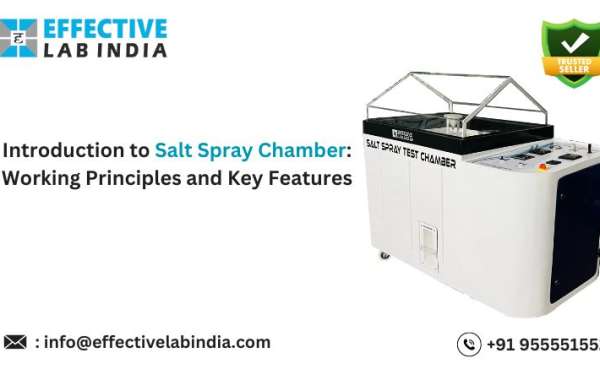Effective Lab Salt spray chambers are specialised testing apparatuses intended to replicate and expedite the corrosive impacts of environments high in salt on a range of materials and goods. These tests are frequently utilized to assess the durability and corrosion resistance of an item in extreme environments, including coastal or marine settings. Be it for metals, construction materials, or electronic components, this chamber is vital in ensuring products can endure the test of time and severe conditions. Let’s dive into what a salt spray chamber is, how it works, and its standout features.
What is a Salt Spray Chamber?
A salt spray chamber, alternatively referred to as a salt fog chamber, replicates and hastens the corrosion process on materials and coatings within a controlled environment. This equipment is essential in laboratories where materials undergo rigorous testing to determine their corrosion resistance. It is particularly important in industries that prioritize longevity and durability.
The Importance of Corrosion Testing
Corrosion can be a silent destroyer, leading to catastrophic failures in materials and structures if not properly managed. By using salt spray chambers, manufacturers and researchers can predict how materials will behave in real-world conditions, ultimately saving time, money, and even lives. Corrosion testing aids in detecting potential weaknesses in materials. This process enables improvements before products reach the market.
How Does a Salt Spray Chamber Work?
The primary function of a salt spray chamber is to create a consistent and controlled corrosive environment. The working principle involves several key components and processes:
1. Saline Solution Preparation: The test begins with the preparation of a saline solution, typically a mixture of sodium chloride (NaCl) and distilled water. The concentration of the solution is usually around 5%, but it can vary depending on specific testing standards and requirements.
2. Atomization of the Solution: The saline solution is then atomized into a fine mist or fog using a nozzle system. This atomization process is crucial as it ensures uniform distribution of the corrosive particles within the chamber. The system directs the mist into the chamber where the test specimens are placed.
3. Test Specimen Placement: Test specimens, such as metal panels, coated surfaces, or assembled components, are strategically placed inside the chamber. The testing protocol determines the exposure period of these specimens to the saline mist, which can range from a few hours to several weeks.
4. Controlled Environment: The chamber maintains a controlled environment with a constant temperature, typically around 35°C (95°F). The system regulates the humidity level to ensure consistent test conditions. Sensors and controllers in the chamber monitor and maintain these parameters throughout the testing period.
5. Corrosion Monitoring: During the test, the specimens are periodically inspected for signs of corrosion. Such as rust, pitting, or coating degradation. We assess the degree of corrosion based on predefined criteria, which can include visual inspection, weight loss measurements, or other analytical methods.
Key Features of a Salt Spray Chamber
Enclosed Chamber: The enclosed chamber is the primary structure of the salt spray test chamber where the test specimens are placed. It contains a corrosive environment, prevents any salt mist from escaping, and ensures a consistent testing atmosphere.
Atomization System: The atomization system is responsible for creating the fine mist of salt solution within the chamber. It includes a spray nozzle that disperses the salt solution into tiny droplets, mimicking natural environmental conditions that cause corrosion.
Temperature Control: Temperature control in a salt spray chamber maintains the internal environment at a specified temperature. The system uses heaters and sensors to regulate and monitor the temperature, ensuring it stays within the required range for the duration of the test.
Humidity Control: Humidity control regulates the moisture levels inside the chamber. Maintaining proper humidity is essential for creating realistic corrosion conditions.
pH Control: pH control ensures that the salt solution maintains the correct acidity or alkalinity levels. The system monitors and adjusts the pH of the solution to match specific testing standards, ensuring consistency and accuracy in the results.
Interlock Safety: The critical safety interlock feature protects users and equipment. This feature helps to avoid accidental exposure to the corrosive environment and ensures the safe operation of the chamber.
HMI Display: The Human-Machine Interface (HMI) display is a user-friendly interface that allows operators to control and monitor the chamber’s functions. It provides real-time data on temperature, humidity, and other parameters, and allows users to set test conditions, start or stop tests, and view historical data.
Applications of Salt Spray Chambers
Automotive Industry: In the automotive sector, we use salt spray test chambers to evaluate the corrosion resistance of car parts, such as body panels, frames, and various metal components. This helps in ensuring the longevity and safety of vehicles.
Construction and Infrastructure: Salt spray chambers help in testing construction materials like steel and concrete reinforcements. Ensuring they can withstand the corrosive effects of environmental exposure, particularly in coastal regions.
Electronics and Electrical Components: Corrosion can be a significant issue for electronic and electrical components. Salt spray testing ensures these components remain functional and reliable, even in harsh conditions.
Key Benefits of Using Salt Spray Chambers for Corrosion Testing
Simplicity: Salt spray chambers are easy to operate with user-friendly interfaces, allowing quick setup and minimal training requirements.
Cost-effectiveness: These chambers are affordable to run, with low-cost materials and durable equipment. Making them a budget-friendly option for corrosion testing.
Standardization: Governed by standards like ASTM B117 and ISO 9227. Salt spray tests ensure consistent and reliable results, facilitating regulatory compliance.
Versatility: Capable of testing various materials, including metals, coatings, plastics, and composites, salt spray chambers are useful across multiple industries.
Acceleration: Salt spray chambers can rapidly simulate years of corrosion in a short time, speeding up product development and issue identification.
Conclusion
Salt spray chambers are indispensable tools in the field of corrosion testing, offering valuable insights into the durability and longevity of materials. By simulating harsh environmental conditions, these chambers help industries improve product quality, ensure safety, and reduce costs through predictive maintenance. As we continue to advance technologically, the role of salt spray chambers will only become more critical in our pursuit of more durable and reliable products.




